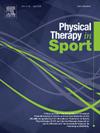Postural control strategies in individuals with and without chronic ankle instability during the reach phase of the posteromedial direction of the star excursion balance test
IF 2.2
3区 医学
Q1 REHABILITATION
引用次数: 0
Abstract
Objective
To compare center of mass (COM) and center of pressure (COP) displacement, joint angles, and muscle activity for the ankle, knee, and hip during the posteromedial (PM) reach direction of the Star Excursion Balance Test between individuals with chronic ankle instability (CAI) and healthy individuals.
Design
Cross-sectional Study.
Setting
Biomechanics laboratory.
Participants
Fifteen individuals with CAI (age: 20.0 ± 1.2 y) and 20 healthy individuals (age: 20.6 ± 0.8 y).
Main outcome measures
The maximum reach distance (MRD). The COM and COP displacement, and ankle, knee, and hip joint angles of the stance limb during the PM reach task measured via a 3D motion analysis system. Electromyography (EMG) was also recorded during the task from the tibialis anterior (TA), soleus, peroneus longus, vastus medialis (VM), biceps femoris, and gluteus medius muscles.
Results
MRD of the CAI group was shorter than the healthy group (P = 0.005). The CAI group showed higher COM positioning (P = 0.007), less knee flexion (P = 0.009), and lower muscle activity in TA (P = 0.04), and VM (P = 0.007) during performance of the PM reach as compared to the healthy group.
Conclusions
These findings suggest that individuals with CAI demonstrate altered postural control strategies during PM reach performance, likely contributing to a shorter MRD.
有或无慢性踝关节不稳的个体在星形偏移平衡测试后内侧方向到达阶段的姿势控制策略。
目的:比较慢性踝关节不稳定(CAI)患者与健康人群在Star偏移平衡测试后内侧(PM)到达方向时,踝关节、膝关节和髋关节的质心(COM)和压力中心(COP)位移、关节角度和肌肉活动度。设计:横断面研究。环境:生物力学实验室。受试者:15例CAI患者(年龄:20.0±1.2岁)和20例健康人(年龄:20.6±0.8岁)。主要观察指标:最大触达距离(MRD)。通过三维运动分析系统测量PM到达任务期间站立肢体的COM和COP位移以及踝关节,膝关节和髋关节角度。在任务期间还记录了胫骨前肌(TA)、比目鱼肌、腓长肌、股内侧肌(VM)、股二头肌和臀中肌的肌电图(EMG)。结果:CAI组的MRD短于健康组(P = 0.005)。与健康组相比,CAI组在PM到达时表现出较高的COM定位(P = 0.007),较少的膝关节屈曲(P = 0.009), TA和VM的肌肉活动(P = 0.04)较低(P = 0.007)。结论:这些研究结果表明,CAI患者在PM到达时表现出改变的姿势控制策略,可能有助于缩短MRD。
本文章由计算机程序翻译,如有差异,请以英文原文为准。
求助全文
约1分钟内获得全文
求助全文
来源期刊

Physical Therapy in Sport
医学-康复医学
CiteScore
4.50
自引率
8.30%
发文量
125
审稿时长
39 days
期刊介绍:
Physical Therapy in Sport is an international peer-reviewed journal that provides a forum for the publication of research and clinical practice material relevant to the healthcare professions involved in sports and exercise medicine, and rehabilitation. The journal publishes material that is indispensable for day-to-day practice and continuing professional development. Physical Therapy in Sport covers topics dealing with the diagnosis, treatment, and prevention of injuries, as well as more general areas of sports and exercise medicine and related sports science.
The journal publishes original research, case studies, reviews, masterclasses, papers on clinical approaches, and book reviews, as well as occasional reports from conferences. Papers are double-blind peer-reviewed by our international advisory board and other international experts, and submissions from a broad range of disciplines are actively encouraged.
 求助内容:
求助内容: 应助结果提醒方式:
应助结果提醒方式:


